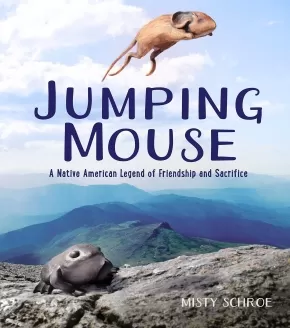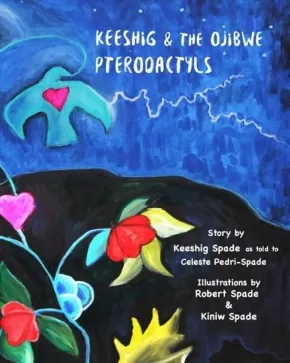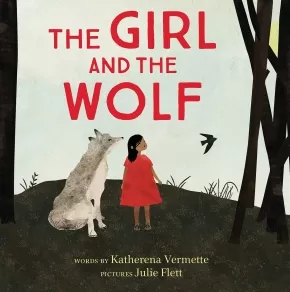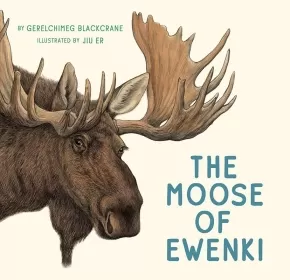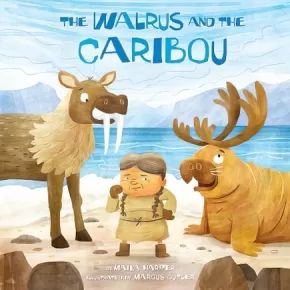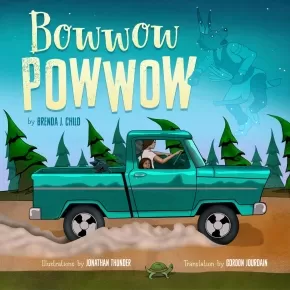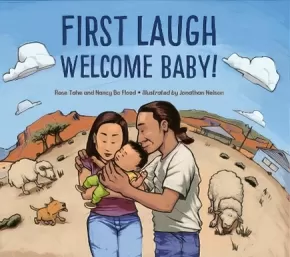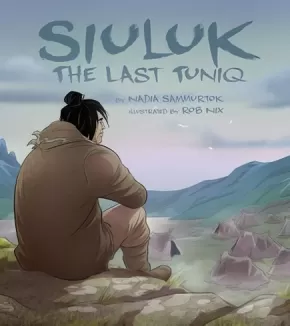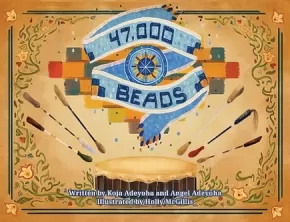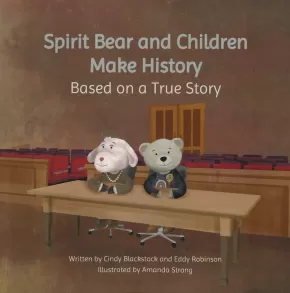
Indigenous
331
-
345
of
372 Results;
Sort By
Go To
of 25
Johnny's Pheasant
$23.99
Artists:
Format:
Hardcover
Text Content Territories:
Indigenous American; Native American;
ISBN / Barcode: 9781517905019
Synopsis:
Synopsis:
An encounter with a pheasant (which may or may not be sleeping) takes a surprising turn in this sweetly serious and funny story of a Native American boy and his grandma
"Pull over, Grandma! Hurry!” Johnny says. Grandma does, and Johnny runs to show her what he spotted near the ditch: a sleeping pheasant. What Grandma sees is a small feathery hump. When Johnny wants to take it home, Grandma tries to tell him that the pheasant might have been hit by a car. But maybe she could use the feathers for her craftwork? So home with Grandma and Johnny the pheasant goes . . .
It’s hard to say who is most surprised by what happens next—Grandma, Johnny, or the pheasant. But no one will be more delighted than the reader at this lesson about patience and kindness and respect for nature, imparted by Grandma’s gentle humor, Johnny’s happy hooting, and all the quiet wisdom found in Cheryl Minnema’s stories of Native life and Julie Flett’s remarkably evocative and beautiful illustrations.
Additional Information
32 pages | 9.50" x 8.50"
Jumping Mouse: A Native American Legend of Friendship and Sacrifice
$26.95
Artists:
Format:
Hardcover
Text Content Territories:
Indigenous American; Native American;
ISBN / Barcode: 9781624148170
Synopsis:
Synopsis:
Jumping Mouse is just like another other mouse, except she has a dream—a dream to reach the fabled High Places. But one small mouse can’t make the long journey alone. At the start of her journey, Jumping Mouse is gifted new long legs from wise Grandfather Frog. Filled with gratitude, she soon meets others who need assistance just like she did: a buffalo that cannot see and a wolf that cannot smell. In order to aid them, she must sacrifice her own sight and hearing, putting her dream of the High Places at risk. Through perseverance and belief, Jumping Mouse discovers who she was truly meant to be, and demonstrates the value of friendship, selflessness, and sacrifice.
Characters come to life through striking photographs of ash-fired ceramic sculptures, giving a fresh twist to this retelling of a timeless tale from the oral tradition.
Educator Information
Recommended for ages 4 to 8.
Additional Information
32 pages | 10.62" x 9.45"
Keeshig and the Ojibwe Pterodactyls
$10.00
Artists:
Format:
Paperback
Text Content Territories:
Indigenous Canadian; First Nations; Anishinaabeg; Ojibway;
ISBN / Barcode: 9781928120209
Synopsis:
Synopsis:
On a hot summer day, a young Anishinabe boy visits the shores of Gitchee Gumee with his mother. Nanaboozhoo, their teacher, is before them, presenting himself as a mass of land that stretches across the horizon. As they visit, Keeshig tells his mother about what he calls "the Ojibwe pterodactyls" that live with Nanaboozhoo. He talks about their hunting and what they like to eat. At the end of the story, Keeshig surprises his mom by sharing that the Ojibwe pterodactyls are indeed the thunderbirds and that they are the heartbeat of Nanaboozhoo. Keeshig's mom is so happy and grateful to hear his story and gives him a big hug, letting him know that he is her heart.
Educator Information
Recommended Ages: 3 - 7
Keeshig's story, transcribed by his mother, is accompanied by stunningly beautiful colour illustrations by his father, Robert Spade, and his brother, Kiniw Spade. This remarkably beautiful children's picture book is a true family effort! Could be used to encourage children to write, illustrate, and share/tell their own stories!
Recommended in the Canadian Indigenous Books for Schools 2020/2021 resource list for grades K-1 in the area of English Language Arts.
Additional Information
22 pages
Nibi's Water Song
$19.99
Format:
Hardcover
Text Content Territories:
Indigenous Canadian; First Nations; Anishinaabeg;
ISBN / Barcode: 9781443107891
Synopsis:
Synopsis:
Determination, teamwork, and perseverance together bring clean water for Nibi and all her friends.
Nibi is the Anishinaabemowin word for water. In Nibi's Water Song, an Indigenous girl is on the search for clean water to drink. Though she is faced with repeated obstacles, Nibi's joyful and determined energy becomes a catalyst for change and action as her community, and then in widening circles the country and government, rally around her to make clean drinking water available for all. In a story perfectly levelled for young readers, there is a strong underlying message that even when a problem seems too large to face, every bit that everyone does helps. And inaction in the face of a wrong is not an option.
Sunshine Tenasco, an Anishinabeg activist for clean water, has an amazing optimistic spirit that shines through her writing. The hopeful tone and lyrical read-aloud quality of this gentle allegorical tale open the door to conversations and action aimed at young children, whether they are on a reserve that does not have clean water or they are living with access to clean water. Chief Lady Bird's stunning, original artwork carries through the themes of strength, hope, and resilience in an incredible collaboration of talent.
Educator Information
Recommended for ages 4-8.
Features of this book include:
- An upbeat story about the importance of clean water.
- Encourages discussion on other environmental issues.
- Author and illustrator are both active in youth outreach and education in their communities.
- Models a way children can bring about change —demonstrating that though young, they are not powerless.
This resource is also available in French: Nibi a soif, très soif
This resource is available in a dual-language format of English and Anishinabemowin: Nibi nigomon/Nibi's Water Song
Additional Information
32 pages
The Eagle Feather Story
$18.95
Artists:
Format:
Paperback
Text Content Territories:
Indigenous Canadian; First Nations; Dene; Dakelh (Carrier);
ISBN / Barcode: 9781926852256
Synopsis:
Synopsis:
The Eagle Feather Story is a beautiful and ancient Dakelh (Carrier Peoples) story about learning to respect people who live their lives with integrity. The story features both the Dakelh and English languages. There is also sections that provide readers with an overview of the Dakelh culture, history and territory. For all ages.
The Eagle Feather Story utilizes concepts from the Dakelh culture to teach about respecting each other and our Mother Earth. The story is beautifully illustrated and features creatures from the Dakelh territory as characters who struggle, but eventually, learn to embody the characteristics and principles that we all strive to live by. The Eagle Feather Story is a tale that encourages people, young and older too, to try to be the best they can be.
Educator Information
This a picture book that is recommended for all ages by its publisher.
Dual-language in Dakelh and English languages.
Storyteller: Francois Prince
Dakelh Language & Translations: Francois Prince and Aggie Anderson
Cultural Advisors: Leona Prince, Mark Barfoot, Kelly Brownbill
Includes a page of questions at the end of the book, entitled "Thoughts For Inquisitive Minds", for children to answer. These questions and discussion prompts relate to the book's content and prompt further conversation, learning, and inquiry.
Additional Information
Approx. 25 pages
The Eagle Inside
$15.99
Artists:
Format:
Paperback
Text Content Territories:
Indigenous Australian;
ISBN / Barcode: 9781760125271
Synopsis:
Synopsis:
A timeless tale about difference, belonging, and courage that will inspire children to have faith in their inner strength.
The smallest bird at school, Jimmy feels certain he will never fit in. But Eagle reminds him that being small isn’t necessarily a weakness, and that being different can also be a strength. This book is loosely based on the author’s university experience of feeling he would never fit in, yet being mentored by a teacher who encouraged him to focus on his inner strength, rather than race or class.
This book is a landmark collaboration between two powerhouses of the Indigenous community of Sydney -- artist, activist, and illustrator Bronwyn Bancroft and her son Jack Manning Bancroft, who is CEO of Australian Indigenous Mentoring Experience (AIME) and has been listed among Sydney's Top 100 Most Influential People.
Educator Information
The publisher recommends this title for ages 3 and under, but it would work better with older children.
Additonal Information
32 pages | 8.75" x 10.75"
The Girl and the Wolf
$22.95
Artists:
Format:
Hardcover
Text Content Territories:
Indigenous;
ISBN / Barcode: 9781926886541
Synopsis:
While picking berries with her mother, a little girl wanders too far into the woods. When she realizes she is lost, she begins to panic. A large grey wolf makes a sudden appearance between some distant trees. Using his sense of smell, he determines where she came from and decides to help her. Through a series of questions from the wolf, the little girl realizes she had the knowledge and skill to navigate herself—she just needed to remember that those abilities were there all along.
Synopsis:
An empowering Indigenous twist on a classic wolf narrative.
While picking berries with her mother, a little girl wanders too far into the woods. When she realizes she is lost, she begins to panic. A large grey wolf makes a sudden appearance between some distant trees. Using his sense of smell, he determines where she came from and decides to help her. Through a series of questions from the wolf, the little girl realizes she had the knowledge and skill to navigate herself—she just needed to remember that those abilities were there all along.
Reviews
"The Girl and the Wolf is about a young girl who wanders too far in the woods and realizes she is lost. A large grey wolf appears, trying to help her find her way back. Through this interaction with the wolf, the girl realizes she has the knowledge and skills all along." - The Dalai Lama Center
"The Girl and the Wolf is about a young girl who wanders too far in the woods and realizes she is lost. A large grey wolf appears, trying to help her find her way back. Through this interaction with the wolf, the girl realizes she has the knowledge and skills all along." - The Dalai Lama Center
Educator Information
Themes: independence, children, knowledge, power, strength, nature, instincts, survival skills.
Themes: independence, children, knowledge, power, strength, nature, instincts, survival skills.
Recommended in the "Canadian Indigenous Books for Schools 2019-2020" resource list as being useful for K-3 students in these subject areas: English Language Arts, Social Studies
Additional Information
32 pages | 8.00" x 8.00"
32 pages | 8.00" x 8.00"
The Moose of Ewenki
$26.95
Artists:
● Jiu Er
Format:
Hardcover
Text Content Territories:
Indigenous Siberian; Ewenki (Evenk);
ISBN / Barcode: 9781771645386
Synopsis:
Synopsis:
From one of China’s most beloved, bestselling children’s authors comes this touching story of friendship and empathy, which celebrates the traditional way of life for the Indigenous Ewenki peoples of Mongolia.
When a Mongolian elder named Gree Shrek hunts a female moose by mistake, her young calf is left behind. Saddened by her loss, Gree Shrek names the calf Xiao Han (“Little Moose”) and the moose and man form an authentic attachment. Xiao Han accompanies Gree Shrek as the hunter-gatherer herds reindeer, sets up camp, forages for food in the forest, and visits his peoples’ village, where many fun adventures happen. But as the little moose grows bigger, Gree Shrek knows he must return his companion to the forest.
Richly detailed, painterly illustrations by Chinese fine artist Jiu’er bring authenticity and beauty to this thoughtful book, which illuminates the traditional and vanishing way of life for the Ewenki peoples of Inner Mongolia.
Reviews
"A surprising bond between an elder hunter and a moose sheds light on the lives of an Inner Mongolian people.... Plodding, endearing, and humorous—not unlike a baby moose." - Kirkus Reviews
Educator Information
Recommended Ages: 5 to 9.
Recommended Grande Range: K to Grade 4.
Curriculum Connections: Fairy Tales and Folklore, Nature and Environment, People and Places, Global Studies
Additional Information
68 pages | 10.00" x 9.50"
The Walrus and the Caribou
$16.95
Artists:
Format:
Hardcover
Text Content Territories:
Indigenous Canadian; Inuit;
ISBN / Barcode: 9781772272567
Synopsis:
Synopsis:
When the earth was new, words had the power to breathe life into the world. But when creating animals from breath, sometimes one does not get everything right on the first try!
Based on a traditional Inuit story passed forward orally for generations in the South Baffin region of Nunavut, this book shares with young readers the origin of the caribou and the walrus—and tells of how these animals looked very different when they were first conceived.
Educator Information
Recommended for ages 5 to 7.
Included in the Canadian Indigenous Books for Schools 2020/2021 resource list for grades 1 to 3 for English Language Arts, Science, and Social Studies.
Additional Information
32 pages | 9.50" x 9.50"
Bowwow Powwow
$25.00
Format:
Hardcover
Text Content Territories:
Indigenous American; Native American; Anishinaabeg; Ojibwe (Chippewa);
ISBN / Barcode: 9781681340777
Synopsis:
Synopsis:
Windy Girl is blessed with a vivid imagination. From Uncle she gathers stories of long-ago traditions, about dances and sharing and gratitude. Windy can tell such stories herself–about her dog, Itchy Boy, and the way he dances to request a treat and how he wriggles with joy in response to, well, just about everything.
When Uncle and Windy Girl and Itchy Boy attend a powwow, Windy watches the dancers in their jingle dresses and listens to the singers. She eats tasty food and joins family and friends around the campfire. Later, Windy falls asleep under the stars. Now Uncle's stories inspire other visions in her head: a bowwow powwow, where all the dancers are dogs. In these magical scenes, Windy sees veterans in a Grand Entry, and a visiting drum group, and traditional dancers, grass dancers, and jingle-dress dancers–all with telltale ears and paws and tails. All celebrating in song and dance. All attesting to the wonder of the powwow.
This playful story by Brenda Child is accompanied by a companion retelling in Ojibwe by Gordon Jourdain and brought to life by Jonathan Thunder's vibrant dreamscapes. The result is a powwow tale for the ages.
Awards
- 2020 American Indian Youth Literature Award winner for Picture Book
- 2019 American Library Association Notable Children’s Book
- 2019 Cooperative Children’s Book Center Best of the Year Choice
- 2018 American Indians in Children’s Literature Best Books
Educator Information
Recommended for ages 3 to 7.
Dual-language: Ojibwe and English
Additional Information
32 pages | 10.00" x 10.00" | Hardcover
First Laugh — Welcome, Baby!
$21.99
Format:
Hardcover
Text Content Territories:
Indigenous American; Native American; Navajo (Diné);
Grade Levels: Preschool; Kindergarten;
ISBN / Barcode: 9781580897945
Synopsis:
Synopsis:
In Navajo families, the first person to make a new baby laugh hosts the child's First Laugh Ceremony. Who will earn the honor in this story?
The First Laugh Ceremony is a celebration held to welcome a new member of the community. As everyone--from Baby's nima (mom) to nadi (big sister) to cheii (grandfather)--tries to elicit the joyous sound from Baby, readers are introduced to details about Navajo life and the Navajo names for family members. Back matter includes information about other cultural ceremonies that welcome new babies and children, including man yue celebration (China), sanskaras (Hindu) and aquiqa (Muslim).
Reviews
"In Navajo families, a baby’s first laugh is more than a developmental milestone—it’s an honor to be the first person who makes the baby laugh, and the event is commemorated with a joyous gathering called the First Laugh Ceremony. The baby in this story, however, is making the family work for his giggles. “Your mouth open wide... It stretches... A smile? Oh, no. It’s a sleepy pink yawn,” write Tahe (a Navajo educator who died in 2015) and Flood (Cowboy Up! Ride the Navajo Rodeo). Not even baby’s ninaai (big brother), with his silly faces, can coax a grin. Then one day, cheii (grandfather) holds the baby high in the air, nima-sani (grandmother) whispers a traditional prayer, and “like babies everywhere—long ago and today—you laugh!” Debut illustrator Nelson, also of Navajo descent, contributes cartooning that captures an expansive, brilliantly hued outdoors and a close-knit family delighted with their newest addition. An extensive afterword gives more information on the ceremony as well as on baby celebrations in other cultures." — Publisher's Weekly
Educator Information
Recommended Ages: 2-5
Includes information about other cultural ceremonies that welcome new babies and children, making this a great resource for discussions of diversity and cultures around the world.
Additional Information
| 32 pages | 8.88" x 9.91" |
Siuluk: The Last Tuniq
$10.95
Artists:
● Rob Nix
Format:
Paperback
Text Content Territories:
Indigenous Canadian; Inuit; Tuniit (Dorset / Palaeoeskimos);
ISBN / Barcode: 9781772271782
Synopsis:
Synopsis:
Siuluk is a very strong man. He’s so strong that people tell him he must be the last of the Tuniit, friendly giants who once lived in the North. Just like those giants, Siuluk is so strong that he can carry an entire walrus over his shoulder.
But not everyone believes that Siuluk is strong. One day, when a group of men tease Siuluk about his size, he has to find a way to prove his strength once and for all—but how?
Based on traditional stories from the Chesterfield Inlet area of the Kivalliq region of Nunavut, this tale of Siuluk and his legendary strength will captivate young readers.
Educator Information
Fountas and Pinnell Level N
Suggested Ages: 5-7.
Additional Information
28 pages | 8.00" x 9.00"
The Gathering
$22.95
Artists:
Format:
Hardcover
Text Content Territories:
Indigenous Canadian; First Nations; Mi'kmaq;
ISBN / Barcode: 9781771084666
Synopsis:
Synopsis:
Alex is attending her first Mi'kmaw spiritual gathering, or mawiomi. Though she is timid at first, older cousin Matthew takes her under his wing. Meeting Elders along the way, they learn about traditional Mi'kmaw culture: the sacred fire, drumming, tanning and moccasin decorating, basket-and canoe-making, and enjoy a Mi'kmaw feast. Most importantly, Alex finds her voice in the talking circle.
With contemporary illustrations by the bestselling illustrator Arthur Stevens, The Gathering is an inclusive story that will educate and entertain Indigenous and non-Indigenous readers alike.
Educator & Series Information
Recommended ages: 4-7
Recommended in the "Canadian Indigenous Books for Schools 2019-2020" resource list as being useful for K-4 students in the areas of English Language Arts and Social Studies.
This book is part of the Indigenous Knowledge Series.
Additional Information
32 pages | 9.00" x 10.00"
47,000 Beads
$15.95
Artists:
Format:
Paperback
Text Content Territories:
Indigenous American; Native American; Sioux; Lakota;
ISBN / Barcode: 9780987976383
Synopsis:
Synopsis:
Peyton loves to dance, and especially at Pow Wow, but her Auntie notices that she’s been dancing less and less. When Peyton shares that she isn't comfortable wearing a dress anymore, Auntie Eyota asks some friends for help to get Peyton what she needs.
Reviews
"How do you stay true to yourself when you don’t feel like you fit in? In 47,000 Beads, young Peyton discovers the power of family, culture, and community as she uncovers the very special role she has as a Two-Spirit person.... Full of colorful, intricate illustrations, this picturebook captures the necessary care, attention, and tiospaye (extended family) support that goes into the creation of the jingle dance regalia. Against this specific context, the book celebrates everyone’s unique identity. The authors reject colonized ideas of gender by using the singular pronoun “they” throughout the book. 47,000 Beads celebrates the resilience of Two-Spirit peoples despite decades of stigmatization and trauma as a result of the oppression of Indigenous peoples in the settler-colonial culture. It is rare, but enlivening, to see a picture book that successfully depicts the continuum of gender identity and expression in a Native community. It is liberating to see a book that frames gender fluid identities as reasons to celebrate." - Emma Heckel, Children's Literature @ UMN
Educator Information
Recommended for ages 6 to 8.
Additional Information
28 pages | 10.75" x 8.25" | Paperback
Spirit Bear and Children Make History: Based on a True Story
$12.95
Artists:
Format:
Paperback
Text Content Territories:
Indigenous Canadian; First Nations;
ISBN / Barcode: 9781777009168
Synopsis:
Synopsis:
"Hello! My name is Sus Zul in the Carrier language. In English, people call me Spirit Bear. I am a proud member of the Carrier Sekani Tribal Council. I am on my way to Ottawa, Ontario, to witness a very important human rights case. Would you join me on this journey?"
When Spirit Bear's mom tells him about an important human rights case happening in Ottawa, Ontario, he makes the LONG trip (by train, his favourite way to travel) to go and watch, and to stand up for First Nations kids.
And he isn't the only one! Lots of children come too — to listen, and to show they care. Spirit Bear knows that children can change the world because he's there to see it happen.
This is the story of how kids — kids just like you — made a difference ... with a bit of help from some bears and other animals along the way!
Educator & Series Information
Spirit Bear and Children Make History tells the story of a landmark human rights case for First Nations children at the Canadian Human Rights Tribunal. Nine years after the case was filed, the Tribunal ruled that the government of Canada was racially discriminating against 165,000 First Nations children by underfunding child welfare and failing to provide equitable public services. The book contributes to the Indigenization of curriculum by centering the agency, histories and realities of First Nations children and communities. The story supports an Indigenous pedagogical approach by encouraging critical and independent thought. In keeping with Indigenous pedagogy, Spirit Bear teaches readers about Indigenous worldviews and values not through direct instruction, but through the modelling of ethical and respectful behaviour and action.
Spirit Bear and Children Make History addresses a gap in reconciliation education. There are few Canadian books for children linking reconciliation with social justice. Meaningful reconciliation in Canada requires the active engagement of children and youth. It also requires a critical and social justice approach that links the residential school system to contemporary inequities and discrimination. Educating children and families about contemporary inequities creates a foundation for change and challenges the myth that colonialism is a thing of the past.
Spirit Bear and Children Make History was written to engage a younger audience in learning about the child welfare case, and to demonstrate and affirm the powerful role of young people in the reconciliation movement. Inspired by the voices of children, and in keeping with to the Truth and Reconciliation Commission’s 94 Calls to Action, the story highlights the power of people of all ages and backgrounds to make a difference for First Nations children and families.
Recommended Grades: K-6
This book is part of the Spirit Bear series.
This book is available in French: Spirit Bear et les enfants passent à l’histoire: Basé sur une histoire vraie
Additional Information
54 pages | 8.25" x 8.25"
Sort By
Go To
of 25




